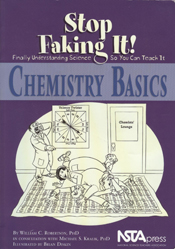Vol.
30 No. 5
September-October 2008
Stop Faking It! Chemistry Basics
William C. Robertson
NSTA Press, Arlington, Virginia, 2007
ISBN 978-0-87355-239-4
reviewed by Parker M. Nelson and Hani Morgan
The thought of taking a course in basic chemistry (secondary or collegiate) usually conjures up feelings of dread for most students. Revealing my background as a chemistry instructor to nonscience types is typically met with a strange look or comment: “Yuck! You teach chemistry?” I often reply by attempting to explain some of the most interesting components of chemistry in the simplest terms possible.
So, what’s an instructor to do? Throw in the towel or acknowledge the difficulty many students have with understanding basic chemistry? The difficulty is all too real, and what doesn’t help matters is the fact that most textbooks explain even simple concepts in a confusing manner. Thus, the need arises for an easy-to-understand guide—one that could serve as a companion volume to basic chemistry textbooks. Stop Faking It! fits the bill.
The book is focused on making science fun and on helping students and teachers understand not only formulas and rules, but their underlying implications. It manages to present scientific information simply—while at the same time diving to an impressive depth of knowledge.
 |
This book is divided into six chapters, each broken into two primary sections: “Things to do before you read the science stuff” and “the science stuff.” Subsequently, the authors then break the topics down even further: “More things to do before you read the science stuff” and “more science stuff.” This pattern usually repeats three to four times per chapter. Each step that the author takes brings the reader deeper and deeper into the presented information without obscuring the basic concepts. The illustrations and examples are designed to develop readers’ conceptual discernment without discouraging them. And lay terminology is used whenever possible, which, paradoxically, seems to enhance the reader’s technical comprehension instead of diminish it.
Chapter Decomposition
Chapter one explains how early Greek philosophers perceived atoms and how their observations were used to explain what atoms are like. This was the time when many scientists believed that four elements existed: fire, earth, air, and water. This depiction of nature was accepted largely because it explained so many observations.
Chapter two shows how an atom’s charge and activity relate to its structure and to subatomic particles. The author stresses the fact although no one has ever seen these particles, they can be used to explain scientific observations.
Chapter three describes the way an atom’s valence, charge, and configuration determine its location on the periodic table. Readers who may become perplexed by the terminology are directed to the informative glossary at the end of the book.
Chapter four reveals why some atoms bond together to form molecules and others do not. The authors explain, for example, why there are two hydrogen atoms and only one oxygen atom in a water
molecule.
Chapter five dives into the world of chemical equations. The authors discuss balancing different types of combustion reactions while enlightening the reader with reference to conservation of mass.
Chapter six explains the basics of organic chemistry by representing carbon atoms as marshmallows; in other words, as sticky atoms that attract other atoms. Using this type of easy-to-grasp analogies facilities learning and creates a bridge that instructors can use to reach across students’ gaps in conceptual knowledge.
From presenting a historical perspective in chapter one to dissecting basic organic chemistry in chapter six, this book does a genuinely fine job of breaking down difficult concepts for students struggling with chemistry. It should be utilized as an additional resource or companion guide for any chemistry textbook. Stop Faking It! Chemistry Basics is strongly recommended to anyone with an interest in basic chemistry.
Parker M. Nelson, M.Ed. <[email protected]> is a doctoral candidate in the Department of Curriculum and Instruction at the University of Southern Mississippi, Hattiesburg. Nelson taught secondary chemistry, physics, and physical science for nearly 12 years and is currently working toward a Ph.D. in secondary education with an emphasis in science. Dr. Hani Morgan <[email protected]> is an assistant professor in the Department of Curriculum and Instruction at the University of Southern Mississippi, Hattiesburg. His areas of study include foundations of education, curriculum, and teaching and international education.
Page last modified 22 September 2008.
Copyright © 2003-2008 International Union of Pure and Applied Chemistry.
Questions regarding the website, please contact [email protected]
|